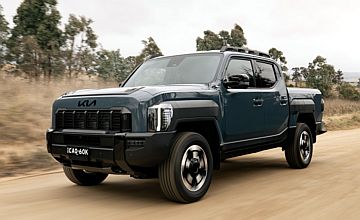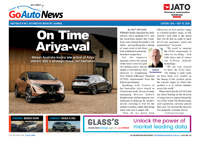Make / Model Search
OptionsCar reviews - Kia - TasmanKia modelsOverviewWe like Standout interior, compliant ride beyond 50km/h, engaging handling for a ute, deft chassis tuning generally, respectable fuel economy, roomy back seat, easy connectivity, baked-in Australian preferences, long warranty Room for improvement Middling four-cylinder performance, no premium engine or hybrid offer, noisy under hard acceleration, deeply polarising styling, ambitious pricing of X-Pro, limited payload when towing 3500kg It’s been a long wait, but the Kia Tasman is finally here – join us for a first drive on home soil1 Aug 2025 By TOM BAKER Overview
ENTERING the fiercely contested midsize pick-up market in Australia against long-established nameplates and frenzied Chinese upstarts isn’t for the faint of heart. In Kia’s case, deliberation on whether to develop a ute took more than 10 years; the decision to launch was made in 2019.
The drawn-out development of Project ‘TK’ resulted in the vehicle we now know as the Kia Tasman, which would have been called the Kia Tanami if Australian product planners had have gotten their way.
It would also have looked more conventional if Seoul didn’t insist on intensely bold styling…
Tasman is the product that debuts an all-new ladder frame developed to engage a range of rivals: the Ford Ranger was extensively benchmarked in late PX Mk III format, with final decisions for the Tasman’s ride/handling package locked in via Australian development in mid-2022.
With rich investment having been poured into a Tasman-specific platform (Kia opted early on not to borrow the 2008-era frame used by its Korean Mohave 4WD product), the marque is advancing plans to expand its rugged lineup to more models, including a wagon to rival the Everest.
The inaugural Tasman release relies on its modernity, deft Australian ride/handling tuning, and a sophisticated interior to overcome criticism of its middling powertrain: a turbocharged 154kW/440Nm 2.2-litre four-cylinder diesel.
A V6 was investigated and ruled out due to NVES regulations.
While the T6.2 Ford Ranger and incoming Toyota HiLux ‘deep facelift’ are clear targets for Tasman, Kia has initially locked its gunsights onto the Isuzu D-Max. A hard sales target of 20,000 until has been set for Tasman, and Kia Australia is determined to hit that goal by nearly any means.
There’s a sense of clear-eyed resolve here, perhaps to be expected from the manufacturer of many of South Korea’s tanks and military utilities.
Still, while Kia is signalling a desire to discount if Tasman falls from its 1600+ monthly sales goal, initial retail pricing is punchy and Ranger-adjacent at the high end, though the fleet-focussed S/SX/SX+ grades offer relative value compared to HiLux Workmate equivalents.
Base S ($46,490 driveaway as 4x2, $53,890 d/a 4x4) isn’t spartan: beyond 17-inch steel wheels, a salubrious cabin is found sporting twin 12.3-inch displays, wireless Apple Carplay/Android Auto, ‘premium’ steering wheel, comfortable cloth seats, LED headlights, AM/FM/DAB radio, and back seats with flip-up storage.
Kia Connect features, including telematics, remote lock/unlock/climate, vehicle location and over-the-air updates are standard with fleet customers increasingly demanding such data.
SX (4x4 only, $58,490 d/a) adds 17-inch alloys, sat nav and stronger highway cruise/lane keep while SX+ ($66,490 d/a) bundles 18-inch wheels, tub liner, dual 240-volt, 400-watt outlets, cloth/artificial leather seats, a wireless device charger, LED taillights and mud guards.
S/SX/SX+ carry a five-star ANCAP rating on the tough 2025 protocol thanks to fitment of a low-set front ‘scoop’ that diminishes their off-roading capability.
Retail-focussed ‘X-series’ models go without the pedestrian kit and are therefore unrated by ANCAP, meaning fleets will largely avoid them.
The $70,990 (d/a) X-Line adds considerable amenity by way of 360-degree and blind spot cameras, artificial leather, 10-way electric driver’s seat adjustment, heated front seats, tilt/slide rear seats, a folding centre console table, acoustic and privacy glass and tray storage cleats.
Finally, the apex X-Pro ($77,990 d/a) completes the package with an electromechanically locking rear differential, ground view camera, cooled front seats, heated rear seats, eight-speaker harman/kardon stereo, sunroof, and 17-inch black alloys in Hankook all-terrain tyres.
What’s missing is a true halo variant to attack the Ford Ranger Raptor and Toyota HiLux GR Sport.
The SmartStream diesel engine rates fairly well in fuel economy terms, with diesel consumption rated at between 7.4L/100km (S 4x2) to 8.1L/100km (X-Pro), the 80-litre tank allowing for near-1000km range. CO2 emissions are 195-214g/km; the 2025 NVES limit is 210g/km.
Driving Impressions
The official gestation of the Tasman was long, and the unofficial debate raged for much longer.
Kia took its time on the Tasman, a factor that has, mostly, resulted in a ute that debuts near the top of its class, with a significant payoff from the extended ride/handling development program.
Deliberately polarising styling aside (Kia wants Tasman noticed), TK’s dynamics and interior push beyond ageing ute stock (HiLux, Navara, D-Max, BT-50) and into competitive territory with familiar pick-ups like Ranger, Amarok, and Triton, and promising newcomers like the BYD Shark 6.
Kia Australia chassis specialists led by Graeme Gambold put their foot down to insist Tasman’s ride/handling/durability compromise did not tilt too far to off-road and payload concerns. Korea was convinced to spend more on suspension to hit heavy duty KPIs while delivering SUV-like handling.
One confrontation occurred in 2022 when, with COVID-19 travel restrictions waning, Australia was dissatisfied with Tasman’s ride; Seoul was talked into upgrading the single-leaf rear suspension to a triple-leaf design while pricey ZF Sachs frequency-selective dampers were locked in range-wide.
Whether Kia Australia demanded and lost the fight to offer the Tasman with a premium engine option beyond the just-adequate four-cylinder is not yet clear. While both petrol and diesel V6 engines were explored, NVES officially put the kibosh on big-six motivation for Tasman.
Compared to rival diesel ‘fours, the Sorento-sourced 2.2-litre mill is at least refined and willing; Kia points to more than 400Nm remaining available to 3000rpm where competitor muscle tails off rapidly. But it’s no V6, and the eight-speed auto pulled from Stinger is a very busy unit.
The diesel engine is quiet at low revs and, driven moderately, is actually quite pleasant. However, merging onto a freeway, overtaking a B-double or simply engaging in some more ‘spirited’ pedalling reveals the modest shortcomings of the SmartStream unit.
That’s a shame because the all-new Tasman chassis could tolerate much more, demonstrating deft front-end tuning and rear-end engagement (altogether a surprising sense of rigid poise) previously exclusive to the T6.2 Ranger/Amarok twins among midsize pick-ups.
Mechanical grip is prodigious, with the Tasman a friendly partner on a country road. Despite the steering rack being mounted in rubber, the electric power steering tune is polished and will feel familiar to Sportage/Sorento customers wanting to add Kia’s dual-cab to their drive.
It’s the ride where Mr Gambold and his team have locked in considerable gains over rival utes. Frequency-selective dampers offer a claimed 30-40 per cent passive adjustment responsive to road surfacing and, while urban ride is firm, compliance beyond 50km/h is very impressive.
Kia is not protective of the fact that only the Tasman X-Pro is really attuned for off-roading, with by far the most ground clearance (252mm) and exclusive fitment of an Eaton electromechanical locking rear differential, plus additional camera views handy during steep ascents.
More than 40 accessories including half and fully-hooped front bars, side steps, powered and manual tub covers, canopies and roof trays will shortly be orderable through Kia’s dealer network while take rates for the towing kit is expected to be high.
A trailer brake controller is standard.
All Tasmans can tow 3500kg (braked), and buyers can opt for 900kg or 1000kg (standard) payload configurations due to tax efficiencies. Taking the latter into consideration, the somewhat limited 6200kg GCM (GVM is 3250kg) means remaining payload is very low when towing the full mass.
Brakes are 325mm ventilated discs all round.
Considering the range is split between fleet-oriented workhorses and the sexier-looking X-series models pitched to weekend warrior tradies, emerging sweet spots appear to be the SX, which undercuts a Toyota HiLux SR in double cab form, and the well-equipped X-Line.
Well-shaped seats feature in every grade, but the X-Line’s upgrade to artificial leather that is heated is a noticeable uptick in perceived premium feeling, though in summer, we suspect the X-Pro’s ventilated pews would be appreciated, with the latter exclusively scoring higher-end audio.
Ergonomics are a strong suit of the Tasman, with steering wheel, stalks, hard climate toggles and clear infotainment menus falling easily to hand. Oddly, a separate 5.0-inch climate control touchpad sits behind the rim of the steering wheel, out of sight; but this is largely superfluous.
Back seat passengers enjoy fairly good legroom for the ute class, with a noted uptick in amenity on X-Line/X-Pro, which have sliding and reclining rear seats that are heated in the poshest of Tasmans. Beneath the back pews are useful storage boxes while the tray measures 1573mm long in SX (1512mm in SX+ and up) and is wide enough for an Australian pallet.
We’d prefer reversing AEB was standard range-wide (rather than being added at X-Line level along with useful blind spot cameras), but the Tasman’s adaptive cruise control and lane centring are slickly tuned among ute rivals, especially with ‘HDA2’ smarts from SX upward.
An extended run across country town, B-road and highway routes netted a real-world fuel economy score of 8.2L/100km in an SX double cab, or around seven per cent adrift of the ADR claim. That’s reasonably good going, being lineball with a Ranger 2.0-litre bi-turbo on a similar loop.
With the luxury of time, Kia closely studied the ute market (at least as it stood until mid-2022) and as a result, the Tasman feels rich and complete in terms of its chassis and cabin, two key elements drivers and operators will interact with every day.
Seismic developments in this fiercely-contested segments – the pace and ferocity of NVES laws on one hand, and the rapid rise of Chinese hybrid utes on the other – were perhaps not predicted by Kia, and both will cause headaches for Tasman’s positioning, price and profitability in future.
Developing a hybrid, or some other premium powertrain with reasonably limited CO2, would have to be a key priority to ensure Kia can keep Tasman sales on the boil long-term in order to efficiently amortise the expensively developed frame.
For now, the Tasman sails into the top third of the ute class.  Read more20th of June 2025  Kia slashes Tasman pricing before launchKia Australia cuts up to $3000 from price of Tasman ute, driveaway pricing now offered17th of April 2025  Kia prices Tasman ute from $42,99024-variant Kia Tasman range offered in 4x2 and 4x4 format, range tops out at $74,990All car reviews Alfa Romeo Alfa Romeo Abarth Abarth Audi Audi Aston Martin Aston Martin BMW BMW Bentley Bentley Chrysler Chrysler Chevrolet Chevrolet Dodge Dodge Citroen Citroen Ferrari Ferrari DS DS Ford Ford Fiat Fiat FPV FPV Foton Foton Haval Haval Great Wall Great Wall Honda Honda Holden Holden Hyundai Hyundai HSV HSV Isuzu Isuzu Infiniti Infiniti Jaguar Jaguar Iveco Iveco Kia Kia Jeep Jeep Land Rover Land Rover Lamborghini Lamborghini Maserati Maserati Lexus Lexus McLaren McLaren Mazda Mazda Mercedes-Benz Mercedes-Benz Mitsubishi Mitsubishi Mini Mini Opel Opel Nissan Nissan Porsche Porsche Peugeot Peugeot Ram Ram Proton Proton Rolls-Royce Rolls-Royce Renault Renault Skoda Skoda Saab Saab SsangYong SsangYong Smart Smart Suzuki Suzuki Subaru Subaru Toyota Toyota Tesla Tesla Volvo Volvo |
OptionsClick to share
|











Facebook Twitter Instagram